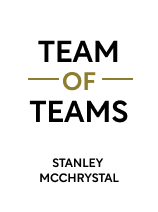

This article is an excerpt from the Shortform book guide to "Team of Teams" by Stanley McChrystal. Shortform has the world's best summaries and analyses of books you should be reading.
Like this article? Sign up for a free trial here .
What was Stanley McChrystal’s take on leadership? What were the four principles that guided his command of the U.S. task force?
When Stanley McChrystal assumed leadership of the JSOC, he channeled his efforts into creating a teamwork ecosystem based on four principles: shared consciousness, trust, cooperation, and empowerment. He nurtured this ecosystem by ensuring that silos and competition didn’t hinder its functioning and that transparency gave it oxygen.
Keep reading to learn about Stanley McChrystal’s leadership principles and how he implemented them to restructure the JSOC.
Stanley McChrystal Takes on Leadership of the JSOC
After the 9/11 attacks, Stanley McChrystal was appointed chief of staff of the US task force operations in Afghanistan. Then in 2003, McChrystal took command of the Joint Special Operations Command (JSOC), which was tasked with a high-profile mission during the Iraqi conflict.
The JSOC struggled to get a handle on an agile enemy constantly on the move with no fixed base of operations, no MO (standard method of operation), and no hierarchy or structure—only a loose network, shifting leaders, and skillful use of cyberspace.
On paper, the task force had a lopsided advantage over AQI:
- Recruitment: U.S. special operators were top quality; AQI recruited disgruntled locals and smuggled in foreign fighters.
- Communications: U.S. specialists had sophisticated and instantaneous communications systems; AQI relied on face-to-face meetings and letters delivered by courier to maintain secrecy in individual operations.
- Training: Special operators underwent extreme training; AQI recruits attended scattered madrassas or religious schools.
- Firepower: Special operators could draw on vast resources, including weapons, electronic surveillance, airpower, and armored vehicles; AQI, working in “safe-house” basements, created IEDs from expired Soviet explosives and propane tanks.
- Persistence: U.S. operators worked around the clock, meticulously planning and executing huge numbers of precise raids with no end in sight; AQI seemed to organize briefly, strike suddenly, then vanish.
Yet, AQI managed to prevail. An example of AQI’s effectiveness against the task force was its September 2004 bombing of a celebration to open Baghdad sewer plant. AQI terrorists drove cars loaded with explosives into the crowd, killing 35 children and wounding 10 Americans and 140 Iraqis. Within hours, AQI had posted a video of its success on the internet.
Despite being the “best of the best,” the task force’s elite special forces, strategists, and intelligence analysts hadn’t discovered the plans and prevented the bombing. Moreover, terrorist attacks like the sewer plant bombing kept increasing. In 2004, there had been more terrorist attacks in Iraq than in the entire world in 2003. They continued to escalate and by spring 2006, attacks were killing more than 1,000 Iraqis a month.
To manage and counter the chaos that AQI nurtured and thrived on, Stanley McChrystal had to transform the entire organization to match both the adaptable enemy and the complex environment. This entailed restructuring based on trust, transparency and information sharing, and decentralized decision-making (empowered execution).
From Chess Master to Gardner
When Stanley McChrystal assumed leadership of the US task force, he had a traditional chess master mindset: he expected to know all the answers and, like a chess player, make all the right moves with his units against Al Qaeda. The task force’s extraordinary technological capability, which gave it eyes everywhere, encouraged this view of being in control of the “game.” However, AQI played a different game, moving multiple “pieces” at speeds the task force initially couldn’t match.
As he realized the way to defeat AQI was to create an agile, adaptable organization, Stanley McChrystal his leadership style from chess master to gardener. He came to view his role as creating an ecosystem—a framework, processes, and culture in which the task force could flourish.
He sought to make fewer decisions and instead focus on creating the conditions for teamwork on an organizational scale: shared consciousness, trust, cooperation, and empowerment.
Empowerment and Shared Consciousness
Navy SEALs apply all of these four qualities to deliver extraordinary performance, adapting to handle unpredictable and complex challenges. The following is an example of how they apply the first two qualities—empowerment and shared consciousness.
In 2009, Somali pirates boarded a U.S. container ship off the coast of Somalia, seized the captain, Richard Phillips, and held him at gunpoint on a small lifeboat.
Two Navy ships arrived on scene with three Navy SEAL snipers who’d been air-dropped onto one of the ships. Through night-vision scopes, the SEALs watched the three pirates holding the captain hostage and waited for the right moment to strike. Suddenly, all three snipers fired simultaneously from 75 feet away, each striking a different pirate in the head without injuring Captain Phillips.
The SEAL team succeeded not only because of their skills, but also because they became essentially one mind, thinking as a unit. Sharing a collective team consciousness or mindset, they each came to the decision to fire at the same time. Additionally, although they were in constant contact with their commander, the snipers acted on their own in choosing the moment to strike.
The team’s structure (empowered members thinking as one) rather than having a centrally determined and controlled plan led to success in this operation.
Trust and Purpose
Besides empowerment and shared consciousness, trust and purpose are critical to team functioning. Navy SEALs training is designed to build trust and purpose so SEALs can function effectively (as the snipers did) as a unit.
Prospective SEALs undergo a six-month, three-part program called Basic Underwater Demolition/SEAL Training (BUD/S). While it involves physical conditioning, diving, and fighting on land, its major purpose is teambuilding. In contrast, command structures like the task force’s initial structure aren’t about teamwork, only following orders.
In SEAL training, trainees rarely do anything alone (not even walking to meals). At minimum, they complete tasks with a partner. They’re divided into crews of five to eight that work together for the six months. They develop trust and learn to function within a small group, communicating, negotiating, and taking cues from each other.
Teams whose members know and trust each other unequivocally are capable of extraordinary performance. Like the snipers who rescued the ship’s captain, these teams can organize a coordinated response on the fly in environments where the complexity exceeds a single leader’s or commander’s ability to predict an outcome or control and monitor the response.
Building Commitment to a Purpose
In addition to building trust, SEAL training ensures that each team member is in sync with their unit’s function, the mission objectives, and their individual role. Part of building this commitment involves making the training so onerous that only the most committed believers complete it—this level of dedication is critical when teammates put their lives on the line for each other and the mission.
A Sense of the Whole
In order for team members to work toward the same goal, they first need an understanding of what the goal is. This contrasts with command structures, like factory assembly lines, where workers don’t need to know the company’s goals, only how to follow directions.
In addition to the overall goal, all members must understand the current playing field. In volatile situations, SEALs are taught to monitor the operation as a whole, much the way soccer players keep track of the whole field. Having a sense of the whole allows SEALs to assess risks and know what actions to take in relation to other team members. They are all responsible for the team’s success and act to ensure it.
Communicating Expectations
Besides creating the right environment, a key part of Stanley McChrystal’s leadership approach was making sure that the priorities and cultural expectations are internalized throughout the whole organization. McChrystal’s steps and actions included:
- Writing brief, carefully crafted daily memos that focused on a few key themes (rather than many) and used repetition to get points across. Although his words competed for attention with a daily deluge of information, he knew they were effective when he heard others echoing them.
- Setting an example by practicing his policies, such as information sharing and frank conversation, particularly in the O&I videoconference. He also wore his combat uniform during the briefings to reinforce his commitment and focus to conference participants in Washington.
- At the O&I briefing, maintaining a balance among sharing, reporting, and Q&As. He also remembered and used the names of presenters to put them at ease, asked questions to show interest, and complimented them to build their confidence and investment in the work.
- Thinking out loud, summarizing what he heard, giving his analysis, and asking the presenter what action he planned to take to demonstrate empowerment.
- Avoiding anger and sarcasm, and saying “thank you” frequently to create an atmosphere that encouraged participation.
- Conveying the message that all problems could be understood and solved together.
The ongoing watering, raking, and fertilizing aspects of gardening are comparable to a commander’s visits (called battlefield circulation) to units. While typical visits are intimidating to the host unit, Stanley McChrystal’s leadership approach was focused on using them to nurture rather than control.
He viewed the visits as an opportunity to:
- Increase his understanding of the unit and its situation
- Gain new insight beyond what’s conveyed in reports
- Communicate information and guidance
- Listen to problems and concerns
As the world becomes increasingly complex, the only way for organizations to function successfully will be as networks of teams nurtured by gardener-leaders, like the joint operations task force in Iraq. Part 5 shows how this kind of team-of-teams operating structure came together enabling the task force to strike successfully against terrorist leader Abu Musab al Zarqawi.

———End of Preview———
Like what you just read? Read the rest of the world's best book summary and analysis of Stanley McChrystal's "Team of Teams" at Shortform .
Here's what you'll find in our full Team of Teams summary :
- How General Stanley McChrystal transformed the U.S. Joint Special Operations Task Force
- What teams that operate well can offer to an organization
- How the team of teams organizational model helped bring down a major Al Qaeda leader






